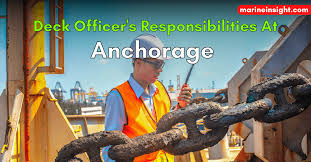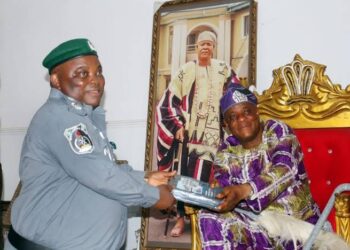
The operation of a ship is a complex activity, especially when it is being carried out away from immediate help and at the mercy of nature. Optimum performance can therefore only be achieved by using the available workforce in an efficient manner.
The very core aspect of watchkeeping is to minimize any prospect of human error and thereby reduce risk of damage to the ship or cargo. More than often, the time at anchorage is considered to be a time to relax. However, depending on the area in which the vessel is operating in, the anchorage might be a time to be extra vigilant.
Seafarers who have been on a vessel anchored outside the Port of Calabar (Nigeria) can relate to the extent to which watchkeeping at anchorage is troublesome! Or anchorage at Singapore for that matter where traffic is abundant and where small errors might lead to full scale disasters.
At anchorage, it is solely up to the Master to decide whether the watch is to be kept on deck or on the bridge. As otherwise, the officer on watch (OOW) has to ensure that all measures are taken for safety of the vessel, its cargo and crew. Here are a few procedures for watchkeeping at anchorage:
1. Calculate the Swinging Circle Swinging Circle (M) = L.O.A + Length of Cable – UKC The swinging circle might vary with the changes in tidal levels and in weather. However, it is important to have a fair idea of the radius around which the ship might move about.
2. Follow the Master’s Standing Orders Every ship’s master writes their own standing orders based on the ship, the experience of its officers, the trade patterns which in turn determine the standing orders. These orders reflect the Master’s requirements based on past experiences with the ship and his contemporary workforce, therefore making it imperative that the orders are followed to prevent any anomaly or to maintain a set grade of performance. Clearly, the master puts faith in the officer when saying “Call me if in doubt” and expects the officer to do so if required and in ample time.
3. Keep a Check on your own Ship and other Ships in the Vicinity Keep a close watch on your ship and other ships in the vicinity lest they start dragging after anchoring. Dragging might occur due to changes in tidal levels, changes in weather or due to the brake giving away to a lot of yawing. The danger here is primarily to ensure that your own vessel does not drag and also to double check if there are other vessels drifting towards your vessel. Use the bow stopper when at anchor to minimize any probability of a blunder.
4. Keep a Constant Check on the Ship’s position. This point is generally laid down in the Master’s Standing Orders and almost always mentions the intervals at which the position must be plotted on the chart. Use the GPS or the Radar or both to determine the exact position of the ship, which, very obviously, helps to determine if the ship is stationery or dragging.
5. Display Appropriate Lights This enables other vessels to know that you are anchored, therefore making it evident that they should not anchor too close to your vessel and also give them an indication of proximity, if dragging occurs.
6. Keeping a Constant VHF watch If slated to receive a pilot onboard or for information on vessels in the area, it is very important to keep a constant VHF watch. The coast authorities generally promulgate extremely useful information that might be integral to the safety of the vessel. Wreckages, vessel information, ETA to pilot etc are necessary data that optimize operational procedures.
7. Alert Nearby Vessels When Required If another vessel seems to be coming close to your own vessel, get their attention on the VHF or by flashing the Aldis lamp. Use any available means at the time to bring to their attention regarding the grave nature of the situation and avert any danger that may be impending. Watchkeeping at anchorage might seem to be an easy task, for there is barely any movement. However, the very fact that the vessel is halted makes it vulnerable to a variety of dangers. As is done usually, the OOW must be vigilant at all times and use the assistance of additional look outs if necessary.
In areas prone to piracy, the importance of alertness cannot be stressed on more. The ship being stationery makes it open to attacks and pilferage. And very little can be left to the imagination in case the pirates attempt to board the vessel when it is anchored! Responsibility and diligence in the part of the OOW will keep the vessel safe and away from harm. That is to say that the OOW should basically just do what he does on an everyday basis and thereby keep the dynamics going.















